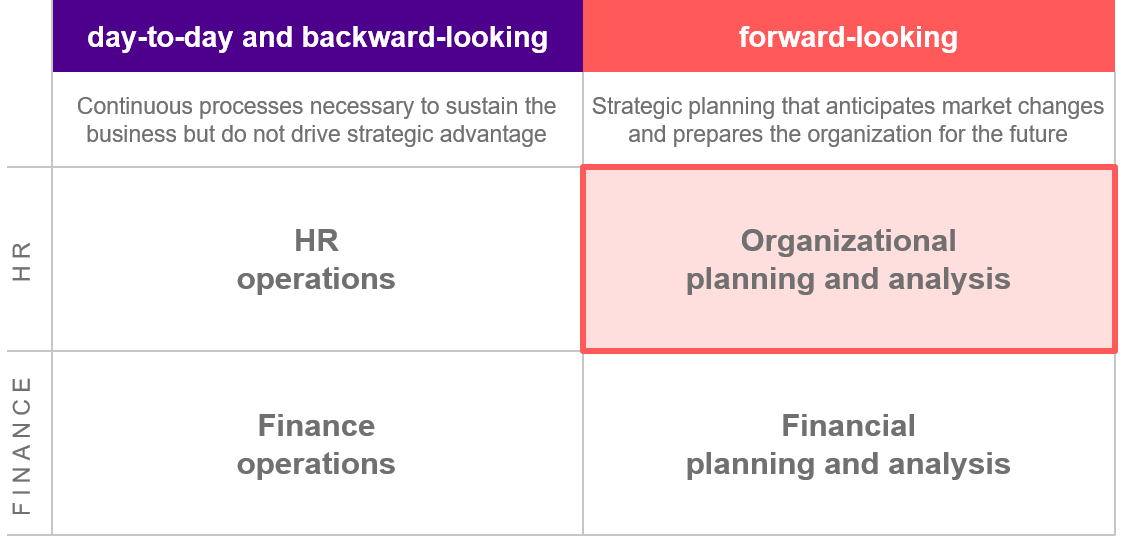Rethinking workforce planning for a disruptive age: OP&A leads the way
An article on organizational planning and analysis (OP&A).
That ‘Eureka’ moment
In recent months, in every interview I had with a potential new CFO for Concentra – there have been many – the one consistent message I heard over and over was how the Finance team should be structured. There is clear delineation between those responsible for financial planning and analysis (FP&A) and then those responsible for day-to-day financial operations. So it dawned on me: how come HR isn’t organized similarly? Shouldn’t there be an Organizational Planning and Analysis (or OP&A) function – a forward-looking, strategic partner to the business? Read on to explore further…
Disruption demands more from HR
The increasing pace of change in the way we work is clearly having a disproportionate effect on HR teams as more is demanded from them. Report after report highlights the need for HR to better support the business. However, in a recent Gartner survey, just 15% of business leaders have changed a decision based on HR data in the past year.
Only 15% of business leaders have changed a decision based on HR data in the past year.
Gartner
Responding to disruption demands new skills within HR, yet 82% of HR executives aren’t sure they have the right people to execute on business strategy . It’s no wonder 60% of CEOs believe that most businesses are not ready to respond to the new future of work. It’s time for HR to step up and embrace new ways of working.
Here’s how.
As FP&A is to Finance, OP&A should be to HR

When considering how HR can be more future-oriented – in terms of planning, budgeting, forecasting – we only need to look across the office to our Finance colleagues.
The Finance function has adopted a model of two halves. One half is “Finance Operations”, responsible for accounting and reporting and, without financial control, you clearly can’t run a business. However, this isn’t the function that prepares the business for the future.
For that there is “Financial Planning and Analysis” or “FP&A” for short. The talent in this team is highly analytical; they develop plans, analyze commercial performance, run models and provide insight to support investment cases. This is the fuel that propels the business forward.
HR is comparable. It also has strong capability in managing the day-to-day activities of the employee lifecycle: recruitment, onboarding, remuneration, training, progression to exiting. Like financial control, it is the life blood of any business. If this fails, the business fails.
But how does HR move the needle onwards? Where is the equivalent “Organizational Planning and Analysis” or “OP&A” function?
Just like FP&A, the OP&A function must be forward-looking and capable of planning, budgeting and scenario analysis of new opportunities. They have a duty to see what’s coming around the corner and prepare the workforce for the future.
What OP&A would answer
- How should the organization be redesigned to better deliver the business strategy?
- Who does what work, and who should do it? What new skills are required?
- What is my people cost now and in the future? How does that track against plan?
- How can decision-making be less bureaucratic, and work streamlined?
- Where can we make efficiency savings in locations, headcount or processes?
5 steps to become future-ready
We have helped many HR teams plan and respond to disruption. The most successful have five things in common. They,
- start with a small, multi-skilled team of more than HR; addressing skills gaps with support from Finance, other parts of the business and/or external experts
- put analytics at the heart of OP&A – it’s data-led with proven methodologies and a results-driven focus
- take a collaborative approach and work together with FP&A teams, sometimes with dual reporting lines
- use purpose-built platforms for the analysis and modeling of data from any sources
- budget for the ongoing work of the OP&A team.
Looking ahead at change, planning for it, getting ready and being ready for it must be a top priority. An OP&A function will enable companies to respond faster and more effectively to disruption and will become a key part of HR teams within the most successful organizations. As FP&A typically absorbs 25% of total departmental budget in Finance, can OP&A aspire to the same in HR?